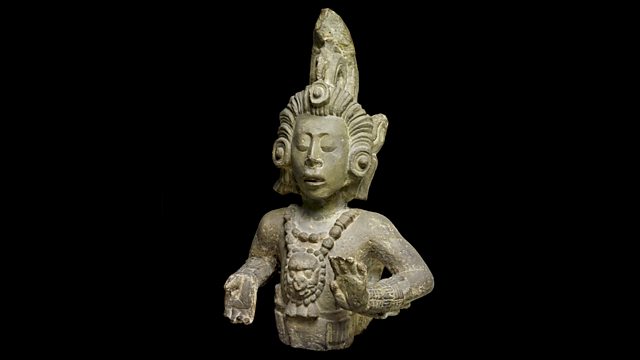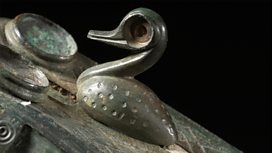Maya Maize God Statue
In a week that observes the emergence of agriculture at the end of the Ice Age, Neil MacGregor tells of a Maize God made of stone by the Mayan people of modern-day Honduras
This week Neil MacGregor is exploring the growing importance of agriculture around the world at the end of the Ice Age, with objects that show and celebrate the key elements of the time; power, sex, worship and food. Today the series focuses on the world of the Mayan civilisation and a stone Maize God, discovered on the site of a major Mayan city in present-day Honduras. This large statue is wearing a headdress in the shape of a giant corn cob.
Maize was not only worshipped at that time but the Maya also believed that all their ancestors were descended from maize. Neil MacGregor reveals why maize, which is notoriously difficult to refine for human consumption, becomes so important to the emerging agriculture of the region.
Neil is joined by the anthropologist Professor John Staller and the restaurateur Santiago Calva who explain the complexity of Mayan mythological belief and the ongoing power of maize in Central America today
Last on
![]()
Discover more programmes from A History of the World in 100 Objects about food and farming
About this object
Location: Copan, Honduras
Culture: Aztec, Maya and Central America
Period: D 715
Material: Stone
��
The statue is of the Mayan maize god. He was found in a pyramid-style temple in Copan in modern-day Honduras surrounded by many other maize gods. In Mayan mythology, the maize god was decapitated at harvest time but reborn again at the beginning of a new growing season. Myths about the death and rebirth of gods helped explain the cycle of the seasons and the return of maize, on which Mayan civilisation depended.
Why did the Mayans worship maize?
The myth of the maize god is just one example of how the development of agriculture led to major changes in how people across the world conceived their gods. For thousands of years the Mayans worshiped the maize god and believed that their ancestors were made from maize dough. Maize was the Mayan's most important food source. Today maize still forms a large part of the Central American diet in the form of tortillas
Did you know?
- Early farmers in Mexico grew chilli to make their maize taste better
Cooking with the Maya
By Thomasina Miers, Owner, Wahaca Mexican Market Eating
��
Corn had a mythical status in Mexico, being an ancient and nutritious crop full of vital minerals like niacin, calcium and riboflavin. Under the Mexica ruler, Moctezuma, corn became a symbol of life and fertility and was offered to the Gods as sacrifice.
Corn is different from other cereals: its nutrients are encapsulated in solid particles that do not crack with heat or water. The Mesoamerican cultures discovered more than 5,000 years ago that cooking corn with lime allows the solid particles to crack, releasing the minerals for the body to absorb.
Grains of corn boiled with lime and water are easily milled to obtain a nutritionally rich dough or ‘masa’. From the masa tortillas, tostadas, totopos, sopes, tlacoyos, chalupas and other Mexican streetfoods are baked.
The Spanish conquistadores did not understand the need for lime. For them, lime was synonymous with death, as they used lime to disintegrate organic matter. So the European colonisers in Mexico did not eat tortillas or other masa products. Instead they imported wheat and with it they baked bread.
Bread became a symbol of wealth and power, tortillas of ignorance and poverty.
The Spanish brought corn to Europe where it easily adapted to the local conditions. It became a staple for poor rural European populations since its yield was much higher than wheat. By the seventeenth century around 60% of the diet of southern Europe consisted of untreated corn. But then disaster struck.
From the 1730s symptoms of digestive disturbances, dementia and death were recorded. The disease was later named pellagra. It killed thousands. It was not until 1930 that it was discovered that pellagra was due to a deficiency in niacin (a mineral that transforms fat and proteins into readily usable body energy). The disease occurred because the Europeans were not able to digest the corn’s nutrients. The culinary secrets of the ancient Mesoamerican cultures had not been learned.
The white corn masa so loved and revered today in Mexico and amongst Mexican communities abroad is still largely unknown to bakers across the world. But the culinary secrets of the ancient Mesoamerican cultures have been preserved for centuries.
Transcript
Broadcasts
- Thu 28 Jan 2010 09:45���˿��� Radio 4 FM
- Thu 28 Jan 2010 19:45���˿��� Radio 4
- Fri 29 Jan 2010 00:30���˿��� Radio 4
- Thu 23 Apr 2020 13:45���˿��� Radio 4
Featured in...
![]()
Food and Farming—A History of the World in 100 Objects
A History of the World in 100 objects - Food and farming
Podcast
-
![]()
A History of the World in 100 Objects
Director of the British Museum, Neil MacGregor, retells humanity's history through objects





